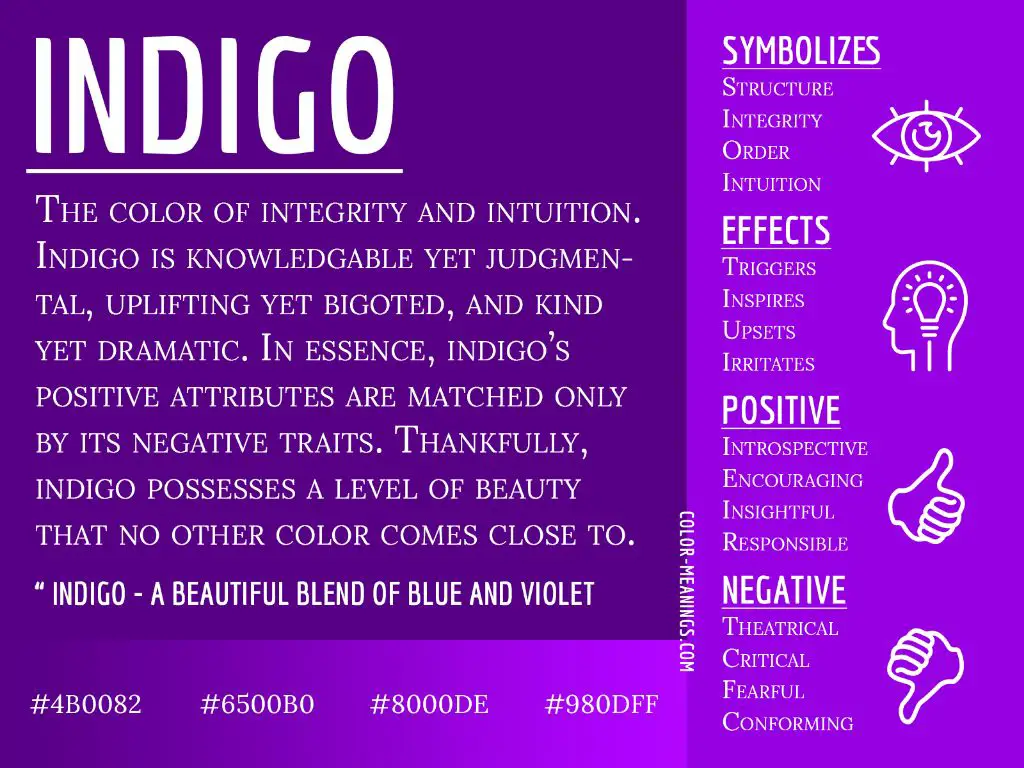What does indigo Colour mean?
Indigo is a deep and rich color between the traditional spectrum of blue and violet. It has long been associated with royalty, spirituality, and creativity. The vivid hue has an enigmatic quality that has inspired many over the centuries. Let’s take a closer look at the origins, symbolism, and uses of the color indigo.
The History and Origins of Indigo
The history of indigo dyeing goes back thousands of years. Here’s a quick overview of where indigo originated and how it was used in ancient cultures:
– Indigo dye is extracted from several plant species, most notably the indigofera tinctoria plant native to Asia and Africa. India is believed to be the oldest center of indigo dye production.
– The earliest recorded use of indigo dye dates back to around 2500 BCE in ancient Egypt, where it was used to color fabrics.
– Indigo was also prevalent in Africa, widely used to dye fabrics in the Yoruba civilization of Nigeria as early as the 12th century.
– Asian cultures like Japan and China have also used indigo as a dye for centuries. It was especially prized for dying silk fabrics.
– In Central and South America, the Maya and Aztec civilizations used indigo to color fabrics made of cotton, hemp, and agave fibers.
So from Asia to Africa to the Americas, indigo dye has been an important part of textile arts and crafts for thousands of years.
The Meaning and Symbolism of Indigo
Beyond its practical applications, indigo has taken on many symbolic meanings across various cultures and belief systems:
| Culture/Religion | Indigo Symbolism |
| Hinduism | Associated with the sixth chakra (third eye), which governs intuition and inner wisdom. |
| Buddhism | Represents spiritual exploration, inner path, and noble path. |
| Ancient Egypt | Connected to the fertilizing flooded waters of the Nile River. |
| Western Esoteric | Associated with divination, clairvoyance, and communication with spirits. |
| New Age | Believed to aid in meditation, relaxation, and clearing of negative energies. |
As you can see, indigo often represents mystical intuition, inner truth, and a bridge between the physical and spiritual realms.
Indigo in Modern Culture and Fashion
Though synthetic dyes have largely replaced plant-based indigo dye today, indigo as a color still has great cultural significance:
– Denim blue jeans get their distinctive color from indigo dye, originally applied to sturdy cotton textiles. Jeans represent the working class and casual everyday wear.
– Indigo is associated with counterculture movements and youth rebellion, from the Beat Generation of the 1950s to punk rockers.
– Navies around the world use indigo dye for their uniforms, hearkening back to its regal pedigree.
– Indigo makes a bold statement in fashion when used for things like blue lipstick or blue hair dye. It represents eccentricity and bold self-expression.
So while indigo may have ancient roots, it still strikes a culturally resonant chord today. The color manages to be both working class and regal, spiritual and rebellious all at once.
Using Indigo in Design and Decor
If you’re looking to incorporate indigo into your own designs, there are creative ways to add this moody blue shade:
– **Paint:** Use indigo blue paint for accent walls or front doors. Deeper indigo works well for elegant dining rooms or offices. Lighter shades can brighten up a bathroom or bedroom.
– **Textiles:** Dye throw pillows, table runners, or curtains with indigo for a pop of color. Use indigo quilts or blankets in living spaces for a cozy look.
– **Ceramics:** Blue and white china patterns (like Delftware pottery) often incorporate indigo motifs. Bring in indigo mugs, vases, or dinnerware for an eclectic tablescape.
– **Clothing:** Wear an indigo cardigan or blouse to add striking style. Indigo dresses and skirts paired with neutrals is a chic combo.
– **Accessories:** Choose indigo shoes, purses, scarves or jewelry as an easy way to work more color into any outfit.
No matter your design aesthetic, there’s likely a shade of rich indigo that can add a punch of visual interest and meaning.
Conclusion
For thousands of years, indigo has captured the imagination with its mystical allure. This deep blue has symbolic ties to ancient cultures across the world, from the flowing Nile waters to the Hindu chakras. Though synthetic dyes have replaced natural indigo, it remains an iconic color today – from counterculture symbolism to regal naval uniforms. With its cultural resonance and striking visual appeal, indigo continues to be a design staple that adds saturated style and meaning to any space.

